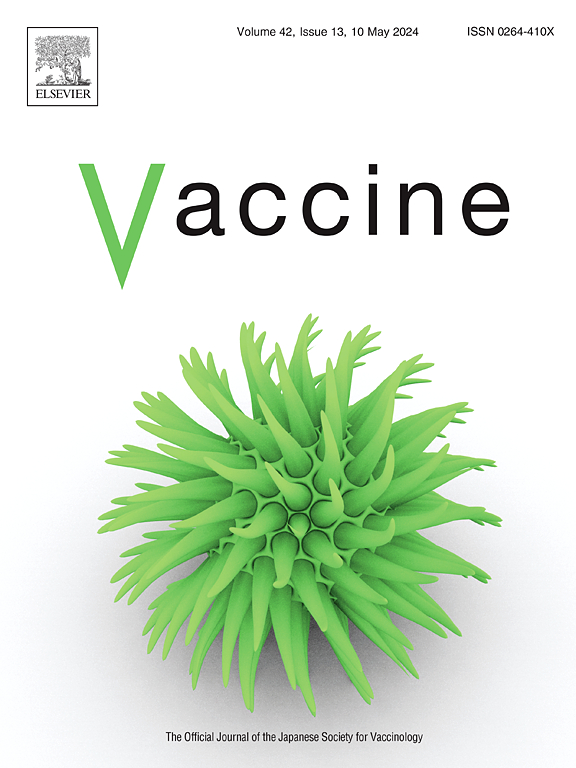南澳大利亚州2018-2022年接种脑膜炎球菌B疫苗(4CMenB)后不良事件监测
IF 4.5
3区 医学
Q2 IMMUNOLOGY
引用次数: 0
摘要
南澳大利亚州(SA)正在进行的全州脑膜炎球菌B疫苗接种计划(该计划)为6周到12个月的儿童和15至17岁的年轻人提供4CMenB (Bexsero)。这项回顾性研究旨在评估4CMenB的安全性,使用常规收集的免疫后不良事件(AEFI)数据。研究人群是该计划的所有参与者,以及从2018年10月1日开始到2022年6月30日通过国家免疫计划(NIP)接种4CMenB的人。根据澳大利亚4CMenB产品信息(PI)和内部B型脑膜炎球菌免疫计划疫苗安全计划(安全计划)对aefi信息进行整理和分类。在研究期间,为该计划和NIP分发(随后未丢弃)的4CMenB疫苗总数为437,462支。在研究期间共收到306份AEFI通报,相当于每10万剂69.9份通报的报告率。大多数报告的AEFI是已知的、常见的、非严重的不良事件(85%的报告),其次是严重的AEFI(13%)和疑似意外的严重不良反应(SUSAR)(2%)。最常见的非严重AEFI临床特征是皮疹(14%)、注射部位反应(14%)、恶心/呕吐/腹泻(11%)和发烧(11%)。在严重AEFI中,最常见的报告是低张力-低反应事件(HHE) (n = 12;30%),需要住院治疗的各种问题(n = 10;25%),高热大于40°C (n = 6;15%)。有5次过敏反应或类过敏反应,4次癫痫发作和2次热惊厥。从严重的AEFI和SUSAR的审查中没有确定具体的新的安全信号。高比例(83%)的两岁以下报告急性脑损伤的儿童服用了预防性对乙酰氨基酚。我们对AEFI的长期、基于人群的分析结果补充了现有的4CMenB疫苗安全性数据,并可用于为其他司法管辖区大规模实施4CMenB疫苗接种计划提供信息。本文章由计算机程序翻译,如有差异,请以英文原文为准。
Surveillance of adverse events following immunisation with meningococcal B vaccine (4CMenB), South Australia, 2018–2022
South Australia (SA)’s ongoing statewide Meningococcal B Vaccination Program (the Program) provides 4CMenB (Bexsero) to children aged six weeks to 12 months, and young people aged 15 to 17 years.
This retrospective study aimed to evaluate the safety profile of 4CMenB, using routinely collected data on adverse events following immunisation (AEFI). The study population was all participants in the Program, as well as those who received 4CMenB through the National Immunisation Program (NIP), from the Program's commencement on 1 October 2018 to 30 June 2022. Information about AEFIs was collated and classified according to the Australian Product Information (PI) for 4CMenB and the internal Meningococcal B Immunisation Program Vaccine Safety Plan (the Safety Plan).
The total number of 4CMenB vaccines distributed (and not subsequently discarded) during the study period for both the Program and the NIP was 437,462 vaccines. A total of 306 AEFI notifications were received during the study period, equating to a reporting rate of 69.9 notifications per 100,000 doses. Most reported AEFI were known, common, non-serious adverse events (85 % of reports), followed by serious AEFI (13 %) and suspected unexpected serious adverse reactions (SUSAR) (2 %). The most frequently reported non-serious AEFI clinical features were rash (14 %), injection site reaction (14 %), nausea/vomiting/diarrhoea (11 %) and fever (11 %). Of the serious AEFI, the most frequently reported were hypotonic-hyporesponsive events (HHE) (n = 12; 30 %), various problems requiring inpatient hospital admission (n = 10; 25 %), and high fever greater than 40 °C (n = 6; 15 %). There were five episodes of anaphylaxis or anaphylactoid reaction, four episodes of seizure and two episodes of febrile convulsion. No specific new safety signal was ascertained from review of serious AEFI and SUSAR. A high proportion (83 %) of children under two years with reported AEFI were administered prophylactic acetaminophen.
Our findings from prolonged, population-based analysis of AEFI complement the existing safety data on the 4CMenB vaccine and may be used to inform the implementation of 4CMenB vaccination programs at scale in other jurisdictions.
求助全文
通过发布文献求助,成功后即可免费获取论文全文。
去求助
来源期刊

Vaccine
医学-免疫学
CiteScore
8.70
自引率
5.50%
发文量
992
审稿时长
131 days
期刊介绍:
Vaccine is unique in publishing the highest quality science across all disciplines relevant to the field of vaccinology - all original article submissions across basic and clinical research, vaccine manufacturing, history, public policy, behavioral science and ethics, social sciences, safety, and many other related areas are welcomed. The submission categories as given in the Guide for Authors indicate where we receive the most papers. Papers outside these major areas are also welcome and authors are encouraged to contact us with specific questions.
 求助内容:
求助内容: 应助结果提醒方式:
应助结果提醒方式:


